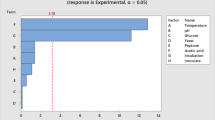Abstract
This study was performed to examine the influence of the controlled glucose supply technology, EnBase® Flo, on growth and heavy metals uptake capacity of two Bacillus strains isolated from food industry wastewater. Bacillus sp. growth on EnBase Flo (mineral salt complex medium containing starch-derived polymer as substrate) was examined in 24 deep well plates, controlling the glucose amount release by adding two amyloglucosidase concentrations (3 and 6 UL−1). Adsorption of the heavy metals Zn2+, Cd2+ and Pb2+ was assessed in a single component system using synthetic metal solutions and as a function of the initial concentration of adsorbate, equilibrium time and removal efficiency. The Langmuir and Freundlich adsorption models were used for the mathematical description of the biosorption equilibrium and isotherm constants. A pseudo second-order model was applied to describe the uptake rate for two isolates. The EnBase® Flo technology improved the cells growth over ten times after 24 h of fed-batch cultivation. The EnBase® Flo technology improved the Cd2+ and Pb2+ uptake capacity of the bacterial strains by approximately 55 and 44 %, respectively. The biosorption of each metal was fairly rapid (within 30 min), which could be an advantage for large scale treatment of contaminated sites. This initial study may be a basis for future developments to apply EnBase Flo for the biomass production used further as biosorbent for heavy metal removal from aqueous solutions.





Similar content being viewed by others
References
Wang J, Chen C (2009) Biosorbents for heavy metals removal and their future. Biotechnol Adv 27:195
Bulut Y, Tez Z (2007) Removal of heavy metals from aqueous solution by sawdust adsorption. J Environ Sci (China) 19:160
Kapoor A, Viraraghavan T (2003) In: Wase J, Forster C (eds) Biosorbents for metal ions. Taylor & Francis Ltd, London
Edyvean RGJ, Williams CJ, Wilson MM, Aderhold D (2003) Biosorption using unusual biomasses. In: Wase J, Forster C (eds) Biosorbents for metal ions. Taylor & Francis Ltd, London, p 178
Kim SU, Cheong YH, Seo DC, Hur JS, Heo JS, Cho JS (2007) Characterisation of heavy metal tolerance and biosorption capacity of bacterium strain CPB4 (Bacillus spp.). Water Sci Technol 55:105
Çolak F, Atar N, Yazıcıoğlu D, Olgun A (2011) Biosorption of lead from aqueous solutions by Bacillus strains possessing heavy-metal resistance. Chem Eng J 173:422
Oves M, Khan MS, Zaidi A (2012) Biosorption of heavy metals by Bacillus thuringiensis strain OSM29 originating from industrial effluent contaminated north Indian soil. Saudi J Biol Sci. http://dx.doi.org/10.1016/j.sjbs.2012.11.006
Volesky B (1990) Biosorption of heavy metals Florida. CRC Press, Boca Raton
Avery SV, Tobin JM (1993) Mechanism of adsorption of hard and soft metal ions to Saccharomyces cerevisiae and influence of hard and soft anions. Appl Environ Microbiol 59:2851
Sandrin TR, Hoffman DR (2007) Bioremediation of organic and metal co-contaminated environments: effect of metal toxicity, speciation and biovailability on biodegradation. In: Singh SN, Tripathi RD (eds) Environmental bioremediation technologies, Springer, Berlin, Heidelberg
Panula-Perala J, Siurkus J, Vasala A, Wilmanowski R, Casteleijn MG, Neubauer P (2008) Enzyme controlled glucose auto-delivery for high cell density cultivations in microplates and shake flasks. Microb Cell Fact 7:31
Krause M, Ukkonen K, Haataja T, Ruottinen M, Glumoff T, Neubauer A et al (2010) A novel fed-batch based cultivation method provides high cell-density and improves yield of soluble recombinant proteins in shaken cultures. Microb Cell Fact 9:11
Glazyrina J, Materne EM, Dreher T, Storm D, Junne S, Adams T et al (2010) High cell density cultivation and recombinant protein production with Escherichia coli in a rocking-motion-type bioreactor. Microb Cell Fact 9:42
Vieira RHSF, Volesky B (2000) Biosorption: a solution to pollution? Int Microbiol 3:17
Vijayaraghavan K, Yun Y-S (2008) Bacterial biosorbents and biosorption. Biotechnol Adv 26:266
Twiss MR, Errécalde O, Fortin C, Campbell PGC, Jumarie C, Denizeau F et al (2001) Coupling the use of computer chemical speciation models and culture techniques in laboratory investigations of trace metal toxicity. Chem Special Bioavailab 13:9
Chojnacka K (2010) Biosorption and bioaccumulation—the prospects for practical applications. Environ Int 36:299
Yilmaz EI, Ensari NY (2005) Cadmium biosorption by Bacillus circulans strain EB1. World J Microbiol Biotechnol 21:777
Baysal Z, Cinar E, Bulut Y, Alkan H, Dogru M (2009) Equilibrium and thermodynamic studies on biosorption of Pb(II) onto Candida albicans biomass. J Hazard Mater 161:62
Binupriya AR, Sathishkumar M, Kavitha D, Swaminathan K, Yun S-E, Mun S-P (2007) Experimental and isothermal studies on sorption of congo red by modified mycelial biomass of wood-rotting fungus. Clean Soil AirWater 35:143
Ho YS, McKay G (1999) The sorption of lead(II) ions on peat. Water Res 33:578
Ho Y (2000) The kinetics of sorption of divalent metal ions onto sphagnum moss peat. Water Res 34:735
Sag Y, Kaya A, Kutsal T (2000) Lead, copper and zinc biosorption from bicomponent systems modelled by empirical Freundlich isotherm. Appl Microb Biotechnol 53:338
Doyle RJ, Matthews TH, Streips UN (1980) Chemical basis for selectivity of metal ions by the Bacillus subtilis cell wall. J Bacteriol 143:471
Volesky B, Prasetyo I (1994) Cadmium removal in a biosorption column. Biotechnol Bioeng 43:1010
Tobin JM, Cooper DG, Neufeld RJ (1984) Uptake of metal ion by Rhizopus arrhizus biomass. Appl Microbiol 47:821
Chatterjee SK, Bhattacharjee I, Chandra G (2010) Biosorption of heavy metals from industrial waste water by Geobacillus thermodenitrificans. J Hazard Mater 175:117
Volesky B (2007) Biosorption and me. Water Res 41:4017
Fourest E, Volesky B (1997) Alginate properties and heavy metal biosorption by marine algae. Appl Biochem Biotechnol 67:215
Acknowledgments
This work was supported by the Deutsche Bundestiftung Umwelt (DBU) and it was coordinated by the Institute of Biotechnology from the Technical University in Berlin, Germany.
Conflict of interest
The authors have declared no conflict of interest.
Author information
Authors and Affiliations
Corresponding author
Rights and permissions
About this article
Cite this article
Palela, M., Bahrim, G.E., Glazyrina, J. et al. Enzyme-based glucose delivery: a possible tool for biosorbent preparation for heavy metal removal from polluted environments. Bioprocess Biosyst Eng 36, 1601–1611 (2013). https://doi.org/10.1007/s00449-013-0934-2
Received:
Accepted:
Published:
Issue Date:
DOI: https://doi.org/10.1007/s00449-013-0934-2




